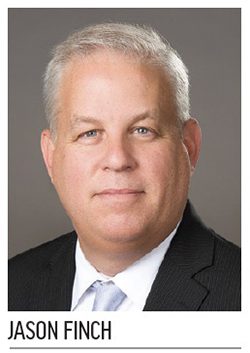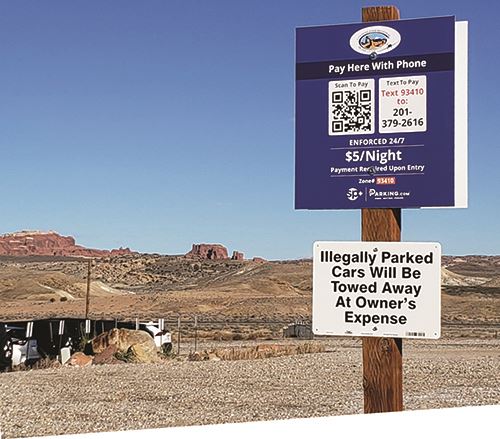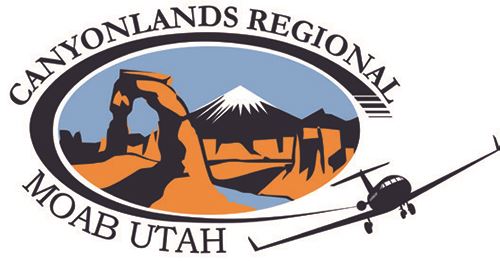Canyonlands Regional Airport (CNY) made the move from an archaic, manual strategy for collecting parking payments to a modern pay-by-phone system last spring. Although the Moab, UT, airport has a humble gravel parking lot without gates or payment kiosks, the benefits of an updated—yet simple—payment collection system and added enforcement measures are proving valuable.
Canyonlands Regional Airport (CNY) made the move from an archaic, manual strategy for collecting parking payments to a modern pay-by-phone system last spring. Although the Moab, UT, airport has a humble gravel parking lot without gates or payment kiosks, the benefits of an updated—yet simple—payment collection system and added enforcement measures are proving valuable.
Changes have occurred over several years, with CNY evolving from free parking to cash payments and eventually adding credit card processing. The latest upgrade uses SP+’s Sphere Technology Platform, allowing customers to pay for parking with smartphones and streamlining the collection process for the airport.
In 2014, SkyWest Airlines discontinued service at CNY because it was upgrading to CRJ200 regional jets, and the airport’s runway was not built to handle them. The airport quickly implemented major runway and terminal upgrades to accommodate the changes from SkyWest, and the airline resumed service at CNY in May 2018. Anticipating increased passenger traffic, airport leadership determined it was time to switch from free to paid parking.
|
Project: Pay-by-Phone Parking System Location: Canyonlands Regional Airport—Moab, UT System: Sphere On-Demand Gateless Pay-by-Phone Provider: SP+ Upfront Cost: About $55 per sign Ongoing Expenses: $500/month plus $0.99 processing fee/transaction Funding: Parking revenue Key Components: Signage with QR code; provided cellphone to scan parked vehicles; printer to issue parking citations Customer Parking Fee: $5/day |
With limited resources and minimal capital available for parking-related infrastructure, the airport opted for a rudimentary manual system for collecting payments. Airport Director Tammy Howland likens it to the honor system used at campgrounds. The airport provided a collection box and envelopes with tear-off permits. Customers were instructed to place cash or check in an envelope, display the associated permit on their dashboard and drop the envelope in the collection box en route to the terminal. Each day, staff members retrieved envelopes from the box, recorded payments on a spreadsheet, counted the cash and checks and deposited the money. They also had to manually audit the spreadsheet from the current day against the previous day to determine which vehicles were still there past the time they had paid to park. It wasn’t unusual for customers to pay short if their return flights changed. And some attempted to park for free.
In 2019, CNY expanded its envelope system to include credit card payments. However, that required travelers to track down an airport employee to process credit card payments.
Moving to Mobile Pay
In late 2021, Howland and other airport staff met with personnel from SP+ at the AAAE Northwest Chapter Conference in Salt Lake City, UT. With 24,748 enplanements that year, CNY assumed it was too small for any of the company’s products or services. But the SP+ team suggested its Sphere Commerce On-Demand Pay with Phone system, which allows customers to pay for parking using a smartphone and major credit card. “The process is very efficient, customer-friendly and creates a frictionless parking experience, which is really important in this post-pandemic world,” says Jason Finch, president–West airports for SP+.
The system is designed for parking facilities with or without gates. At facilities with gates, Sphere supplements the parking access revenue control system with an additional option for entry and exit.
Howland and her team were immediately interested because the Pay with Phone system wouldn’t require additional infrastructure like entry and exit lanes or payment kiosks. All CNY would need was new signage. The price and operational simplicity were also appealing, adds Howland. “As soon as I got back, I got the ball rolling with our airport director at the time to get the system approved by our county government to get it put in place,” she recalls.
Getting Started
The airport established a service contract with SP+ for the new system and opted to keep the existing $5/day parking fee the same. It also had the choice of adding a penalty fee for violations.
SP+ and its internal Technology Integration Group helped CNY create signage that displays a custom QR code and zone number unique to the airport. After SP+ performed testing and live scanning to ensure the process was working correctly, the airport installed the signage. Then, SP+ provided virtual training for airport staff, including lessons about enforcement and the citation process. The company supplied a smartphone that airport staff use to scan license plates and capture vehicle makes and models. Later, CNY added an optional Bluetooth thermal printer that is connected to the handheld device to print citations, also provided by SP+.
 From an ongoing standpoint, SP+ provides the airport with monthly operating statements that account for all payments and transactions—data that was previously cumbersome for the airport to collect. “You can appreciate the challenges for these primary non-hub airports,” Finch remarks. “They’ve got to be Jacks of all trades.”
From an ongoing standpoint, SP+ provides the airport with monthly operating statements that account for all payments and transactions—data that was previously cumbersome for the airport to collect. “You can appreciate the challenges for these primary non-hub airports,” Finch remarks. “They’ve got to be Jacks of all trades.”
SP+ also provides tech support as needed seven days a week, essentially becoming an extension of CNY’s staff. “They don’t push us to the back burner because we’re not a huge airport,” Howland reports.
How It Works
By deploying the SP+ Sphere Technology Platform, CNY is able to provide customers with a touchless parking option, which is important for COVID-conscious customers and staff alike. Travelers park their vehicles and then scan a QR code on the signage in the parking lot or terminal with a phone. Alternately, they can send a text message to the phone number listed on the signs. This opens a parking.com page specific to CNY, and travelers enter their license plate number, contact information, credit card information and length of stay; and then make their payment. Travelers who already have the parking.com app on their phone enter the CNY zone number and length of stay to make payment.

Customers receive email receipts to confirm payments and are given the option of creating a parking.com account with their vehicle and payment information saved for future use. At CNY, the system sends travelers a text message two hours before their booked parking time runs out, and asks if they want to extend their parking stay. This accommodates flight changes and helps prevent violations. “It’s super quick and easy on their phones,” Howland says.
To verify payment and enforce parking in the airport lot, CNY staff use the smartphone provided by SP+ to capture license plates and vehicle make and model information. They can also enter this information into the SP+ app on the phone. The cloud-based Sphere system uses a customer account management program powered by SP+’s MySpot inventory pricing engine to determine whether each vehicle is up to date on their payment. “You just scan all of [the vehicles] with the phone,” Howland says. “It keeps track of it, and then you can go on to your next project for the day rather than having to come back and go through all your spreadsheets.”
If a parker doesn’t pay for the full duration of his or her stay, the system indicates a violation, and an airport employee uses the mobile printer to create a parking citation to place on the vehicle’s windshield. The citation ticket provides instructions about where to mail payment. If a citation is not paid within 30 days, SP+ turns it over to a collection agency.
To document a violation, an airport worker takes multiple time-stamped photos of the vehicle showing what date and time it was in the parking lot. Even if a customer loses (or supposedly loses) the citation, a record of the violation stays in the SP+ Sphere Commerce Enforcement system and appears in documentation SP+ provides to the airport. Information is available within an online dashboard and reporting portal, and airport administration can void or discount violations as necessary.
Benefits and Challenges
Howland says that switching to the SP+ system has significantly improved the process of generating and collecting parking revenue. “To do it in a more efficient, less labor-intensive manner is a win for the airport,” she elaborates. “Overall, the easier we can make it for the customer, the better our collection rate is.”
Staff members report that feedback from travelers has been positive, with many describing the system as user-friendly. “We’ve actually had people that were super-excited and super-happy because it’s quick to use,” remarks Andrea Erwin, a CNY landside operations technician.
It is important for parkers who have downloaded the parking.com app to enter the zone number for CNY. “If they don’t put in the zone number, then it won’t let them pay,” Erwin notes. As long as travelers scan the QR code, send a text to the phone number on the parking signs or enter the zone number, it links right to the system and makes it quick and easy, she adds.
Because the system did not require any new gates or additional infrastructure, the project team did not experience challenges or delays from supply chain issues. “The beauty behind the system truly is its simplicity, both from an implementation standpoint and ease of use and acceptance by the customer,” Finch remarks.
The airport sees its new parking system as a tool to facilitate growth and improve customer satisfaction while collecting much-needed parking revenue in a more efficient manner. Howland also considers it to be a great way to show visitors that CNY leadership is actively working to make the airport better. “And it’s only going to get better from here,” she adds.
Howland says the Pay with Phone system from SP+ is a good fit for the airport’s budget and existing facilities. “We didn’t have the infrastructure to be able to put in gates, kiosks and ticket machines that you see at larger airports,” she remarks. “This has given us the ability to effectively collect that revenue without putting a ton of resources into infrastructure.”
Finch notes that Sphere On-Demand Gateless Pay with Phone helps small airports transition from hoping that customers pay for parking to automatically receiving the revenue they are due. “Gaining control of the parking system with little to no capital expense in a quick-to-market solution can really benefit airports looking to maximize their non-aeronautical revenue streams,” he comments.

Leveraging collection technology can also help airports recoup significant costs associated with providing safe, clean and well-lit parking for customers, he adds. Case in point: CNY may use parking revenue to upgrade its parking lot from gravel to pavement at some point in the future. In 2019, CNY collected about $25,670 in parking fees; and from January through October 2022, the airport had collected $20,102.
Erwin gives SP+ high marks for training and technical support. “We’ve sent them emails on the weekend, and they actually will reply back to us on the weekend, which is great because we’re open seven days a week,” she remarks. “You always have that support if you need it.”
Coming Up
The team at CNY has multiple projects in the works over the next few years. There are four design projects in 2023, with construction of 9,000 linear feet of 8-foot wildlife fence, construction of a taxiway connector and additional ramp work scheduled for 2024. The airport also plans to add a snow removal equipment building in 2023, acquire a Reduced-Size Explosives Detection System for TSA baggage screeners and modify space in the terminal to accommodate this machine.
The various projects and investments are tied to increased tourism in Moab. “It’s a rapidly growing airport,” Howland notes, “so it’s a sprint to keep up.”




